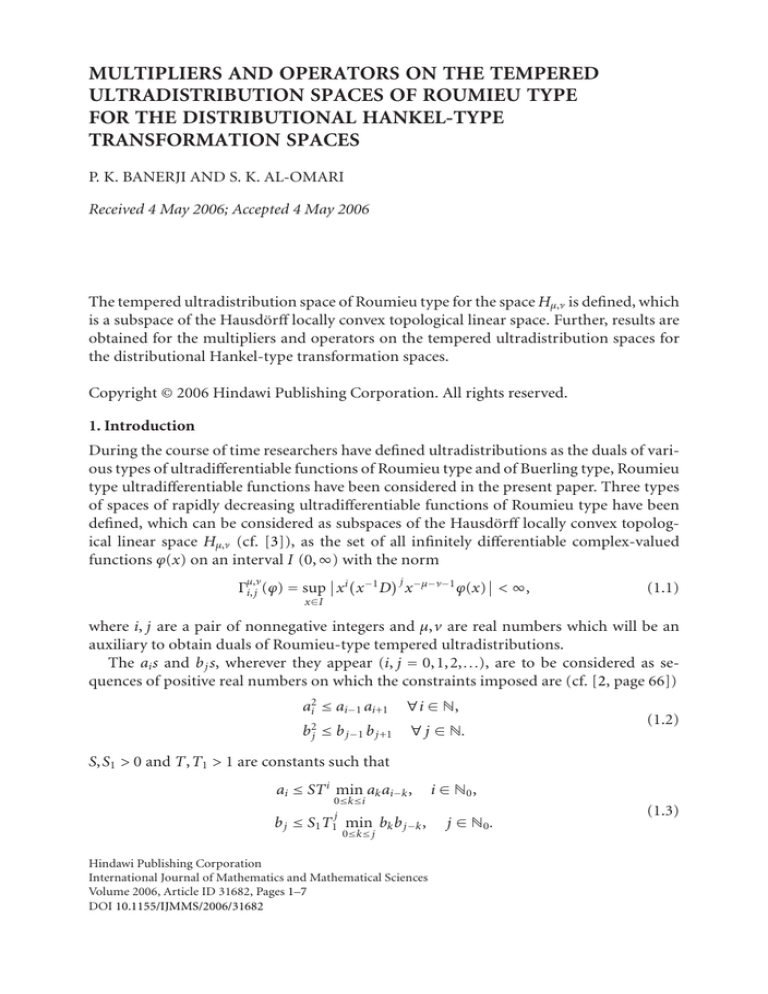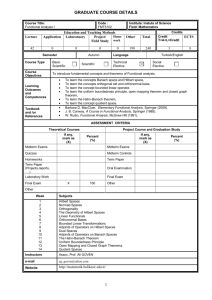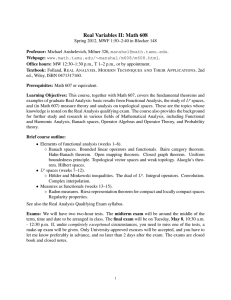
MULTIPLIERS AND OPERATORS ON THE TEMPERED
ULTRADISTRIBUTION SPACES OF ROUMIEU TYPE
FOR THE DISTRIBUTIONAL HANKEL-TYPE
TRANSFORMATION SPACES
P. K. BANERJI AND S. K. AL-OMARI
Received 4 May 2006; Accepted 4 May 2006
The tempered ultradistribution space of Roumieu type for the space Hμ,ν is defined, which
is a subspace of the Hausdörff locally convex topological linear space. Further, results are
obtained for the multipliers and operators on the tempered ultradistribution spaces for
the distributional Hankel-type transformation spaces.
Copyright © 2006 Hindawi Publishing Corporation. All rights reserved.
1. Introduction
During the course of time researchers have defined ultradistributions as the duals of various types of ultradifferentiable functions of Roumieu type and of Buerling type, Roumieu
type ultradifferentiable functions have been considered in the present paper. Three types
of spaces of rapidly decreasing ultradifferentiable functions of Roumieu type have been
defined, which can be considered as subspaces of the Hausdörff locally convex topological linear space Hμ,ν (cf. [3]), as the set of all infinitely differentiable complex-valued
functions ϕ(x) on an interval I (0, ∞) with the norm
μ,ν
j
Γi, j (ϕ) = sup xi x−1 D x−μ−ν−1 ϕ(x) < ∞,
x ∈I
(1.1)
where i, j are a pair of nonnegative integers and μ,v are real numbers which will be an
auxiliary to obtain duals of Roumieu-type tempered ultradistributions.
The ai s and b j s, wherever they appear (i, j = 0,1,2,...), are to be considered as sequences of positive real numbers on which the constraints imposed are (cf. [2, page 66])
a2i ≤ ai−1 ai+1
∀i ∈ N,
b2j ≤ b j −1 b j+1
∀ j ∈ N.
(1.2)
S,S1 > 0 and T,T1 > 1 are constants such that
ai ≤ ST i min ak ai−k ,
0≤k≤i
j
b j ≤ S1 T1 min
0≤k≤ j
bk b j −k ,
Hindawi Publishing Corporation
International Journal of Mathematics and Mathematical Sciences
Volume 2006, Article ID 31682, Pages 1–7
DOI 10.1155/IJMMS/2006/31682
i ∈ N0 ,
j ∈ N0 .
(1.3)
2
Tempered ultradistribution space of Roumieu type
As a consequence of (1.2), we have (cf. [1])
ai ak ≤ a0 ai+k ,
i,k ∈ N0 ,
b j bk ≤ b0 b j+k ,
j,k ∈ N0 .
(1.4)
v
is the space of all those functions, defined on interval I, and are
Definition 1.1. (I) Hμ,a
i ,A
infinitely smooth, for which
i −1 j −μ −ν −1
μ,ν
x x D x
ϕ(x) ≤ C (A + α)i ai ,
j
i, j ∈ N0 ,
(1.5)
μ,ν
where A and C j are constants depending on ϕ and α is an arbitrary positive constant.
v,b j ,B
(II) Define ϕ ∈ Hμ
whenever ϕ is smooth and the inequality
i −1 j −μ −ν −1
μ,ν
x x D x
ϕ(x) ≤ C (B + β) j b j
j
(1.6)
is true for all i, j ∈ N0 .
v,b j ,B
(III) For ϕ being a smooth function, ϕ(x) ∈ Hμ,ai ,A , which satisfies the inequality
i −1 j −μ −ν −1
x x D x
ϕ(x) ≤ C μ,ν (A + α)i (B + β) j ai b j ,
(1.7)
where i, j ∈ N0 (arbitrary constants) and α,β > 0, A, B, and C μ,v are positive constants
depending on ϕ.
v,b j ,B
v,b j ,B
v
, Hμ , and Hμ,ai ,A are defined as
The norms on the spaces Hμ,a
i ,A
μ,v
ϑ j,α (ϕ) =
μ,v
ϑi,β (ϕ) =
sup
x∈(0,∞)
i∈N0
sup
x∈(0,∞)
i∈N0
i −1 j −μ−v−1
x x D x
ϕ(x)
(A + α)i ai
i −1 j −μ−v−1
x x D x
ϕ(x)
(B + β) j b j
,
(1.8)
,
where i, j = 0,1,2,3,... and α,β = 1,1/2,1/3,..., and
μ,v
ϑα,β (ϕ) =
sup
x∈(0,∞)
i, j ∈N0
i −1 j −μ −v −1
x x D x
ϕ(x)
(A + α)i (B + β) j ai b j
,
(1.9)
for the conditions already mentioned.
v,b j ,B
v,b j ,B
The duals of the spaces, defined earlier, are denoted by H vμ,ai ,A , H μ , and H μ,ai ,A ,
respectively, which, indeed, are Roumieu-type ultradifferentiable functions. Whereas the
duals are the tempered ultradistributions of Roumieu type.
v,b j ,B
v,b j ,B
v
, Hμ , and Hμ,ai ,A being the subspaces of the space Hμ,v , indeed,
The spaces Hμ,a
i ,A
Hμ,v will be a subspace of their duals.
P. K. Banerji and S. K. Al-Omari 3
2. Multipliers for ultradifferentiable functions
This section deals with results, which justify certain mapping to be linear on the three
spaces defined earlier. The following definition will make sense in the analysis of the results.
b j ,B0
Definition 2.1. Denote by Ᏹai ,A0 ,Ᏹb j ,B0 , and Ᏹai ,A0 the set of all complex-valued infinitely
differentiable functions (C ∞ -functions) θ (x) on the interval (0, ∞), which satisfy the
following:
−1 i
x D θ(x) ≤ CAi ai 1 + xr ,
0
−1 j
x D θ(x) ≤ CB j b j 1 + xr ,
(2.1)
0
−1 j
x D θ(x) ≤ EAi B j a j b j 1 + xr ,
0 0
where C, D, E are positive constants and r > 0 is an arbitrary integer.
v,b j ,B
v
,Hμ
Theorem 2.2. Let ϕ ∈ Hμ,a
i ,A
μ,ν
v,b j ,B
, and Hμ,ai ,A , respectively. Then
μ,ν
ϑ j,1/n (ϕ) ≤ ϑ j,1/(n+1) (ϕ),
μ,ν
μ,ν
μ,ν
ϑi,1/n (ϕ) ≤ ϑi,1/(n+1) (ϕ),
μ,ν
ϑ1/n (ϕ) ≤ ϑ1/(n+1),1/(n+1) (ϕ),
(2.2)
respectively.
Proofs of the above inequalities are straightforward consequences of (1.8) and (1.9),
respectively. The details are thus avoided.
ν
. Then
Theorem 2.3. Let θ ∈ Ᏹai ,A0 and ϕ ∈ Hμ,a
i ,A
μ,ν
j
ϑ j,α (θϕ) ≤ 2CA0 a j
j
k =0
j μ,ν
ϑ
(ϕ),
k j −k,α
(2.3)
v
into itself.
that is, the mapping ϕ → θϕ is a continuous linear mapping on Hμ,a
i ,A
Proof. By virtue of Leibniz theorem and employing (1.5) and Definition 2.1, we obtain
i −1 j −μ −ν −1
x x D x
(θϕ)(x)
j k
j
−1 j −k −μ−ν−1
x−1 D θ(x) i r
x 1+x x D
x
ϕ(x)
=
k
1 + xr
k =0
≤
j
k =0
j −k −μ−ν−1
j
j CA0 a j xi x−1 D
x
ϕ(x)
k
+ xi+r x−1 D
j −k
x−μ−ν−1 ϕ(x) .
(2.4)
4
Tempered ultradistribution space of Roumieu type
By multiplying by 1/(A + α)i ai and considering the supremum over all integers i > 0, for
all x ∈ (0, ∞), the above relation is expressed as
sup
i −1 j −μ −v −1
x x D x
(θϕ)(x)
(A + α)i ai
i∈N0
x∈(0,∞)
j
≤
k =0
⎡
i −1 j −k −μ−v−1
x x D
⎢
x
ϕ(x)
j
j
⎢
CA0 a j ⎣ sup
k
(A + α)i ai
i∈N0
(2.5)
x∈(0,∞)
⎤
i+v −1 j −k −μ−v−1
x
x D
x
ϕ(x) ⎥
⎥,
+ sup
⎦
(A + α)i a
i
i∈N0
x∈(0,∞)
that is,
μ,v
j
ϑ j,α (θϕ) ≤ CA0 a j
j
k =0
μ,ν
j ϑ j − k,αμ,ν (ϕ) + ϑ j −k,α (ϕ),
k
(2.6)
that is,
μ,v
j
ϑ j,α (θϕ) ≤ 2CA0 a j
j
j μ,ν
ϑ
(ϕ).
k j −k,α
k =0
(2.7)
This completes the proof of the theorem.
Theorem 2.4. If Ᏹb j ,B0 and b j satisfy the relation (1.4), then for all ϕ ∈
ϕ → θϕ is a continuous linear map on the space
μ,v
j
ϑ j,α (θϕ) ≤ 2Db0 B0 b j
v,b j ,B
Hμ
j
k =0
v,b j ,B
Hμ ,
the map
into itself, that is,
j μ,ν
ϑ
(ϕ).
k j −k,β
(2.8)
Proof. Employing Definition 2.1 to (2.8) and multiplying it by 1/(B + β) j b j , we have
i −1 j −μ −ν −1
x x D x
(θϕ)(x)
(B + β) j b j
≤
j
k =0
j −k −μ−ν−1
j
j DB0 b j xi x−1 D
x
ϕ(x)
k
+ xi+v x−1 D
j −k
(2.9)
x−μ−ν−1 ϕ(x)
1
.
(B + β) j b j
Now by virtue of (1.4), 1/b j ≤ b0 /bk b j −k . Owing to j − k >0, xi ≤ xi+r for all i,r > 0,
P. K. Banerji and S. K. Al-Omari 5
from (2.9) we have
i −1 j −μ −ν −1
x x D x
(θϕ)(x)
(B + β) j b j
≤
j
i −1 j −k −μ−ν−1
x (x D) x
b j b0
ϕ(x)
j
j
DB0
k
bk (B + β)k
(B + β) j −k b j −k
k =0
+
(2.10)
i+r −1 j −k −μ−ν−1
x
x D
x
ϕ(x)
(B + β) j −k b j −k
for all integers j > 0, and for all x ∈ (0, ∞), we consider the supremum to obtain
μ,v
j
ϑi,β (θϕ) ≤ 2Db0 B0 b j
j
k =0
j μ,ν
ϑ
(ϕ).
k i+r,β
(2.11)
The theorem is thus completely proved.
Theorem 2.5. If θ
b j ,B0
∈ Ᏹai ,A0 ,
v,b j ,B
ϕ ∈ Hμ,ai ,A ,
and b j satisfy (1.4), then
μ,v
ϑi,β (θϕ) ≤ C
j
k =0
j
k
μ,ν
bk
ϑα,β (ϕ),
(2.12)
v,b j ,B
that is, the mapping ϕ → θϕ is a continuos linear mapping on Hμ,ai ,A into itself, where C =
j
j
EA0 B0 ai b j b0 .
Proof. By virtue of (2.8) and Definition 1.1, we are led to
i −1 j −μ −ν −1
x x D x
(θϕ)(x)
≤
j
k =0
j −k −μ−ν−1
j
j j
EA0 B0 a j b j xi + xi+r x−1 D
x
ϕ(x).
k
(2.13)
Now multiplying this relation by 1/(A + α)i (B + β) j ai b j , we conclude, indeed, that 1/(B +
β)k ≤ 1, that is,
i −1 j −μ −ν −1
x x D x
(θϕ)(x)
(A + α)i (B + β) j ai b j
≤
j
k =0
j −k
i
i+r x −1 D
b j −k x−μ−ν−1 ϕ(x) j
j j
x +x
.
EA0 B0 a j b j
j
−
i
k
bj
(A + α) (B + β) k ai b j −k
(2.14)
6
Tempered ultradistribution space of Roumieu type
Further, employing (1.4) and as usual taking the supremum over all x ∈ (0, ∞), i, j ∈ N0 ,
we have
j
μ,v
ϑi,β (θϕ) ≤ C
k =0
j
k
bk
μ,ν
ϑα,β (ϕ),
where C has the usual meaning. Thus, the theorem is completely proved.
(2.15)
3. Operators for the duals of tempered ultradistribution
In this section, a lemma is proved to establish the isomorphism between the spaces which
are infinitely smooth and defined on (0, ∞), described in Section 1 and further, a mapping
is proved to be an isomorphism between duals of these spaces.
Lemma 3.1. For k being a nonnegative integer, the mapping ϕ → xk ϕ is an isomorphism
v,b j ,B
v,b j ,B
v+k,b j ,B
v,b j ,B
v
v+k
, Hμ , and Hμ,ai ,A onto Hμ,a
, Hμ
, and Hμ,ai ,A , respectively.
from the spaces Hμ,a
i ,A
i ,A
v,b j ,B
v,b j ,B
v
,Hμ , and Hμ,ai ,A , respectively.
Proof. Let ϕ ∈ Hμ,a
i ,A
v
In the case ϕ ∈ Hμ,ai ,A , we write
i −1 j −μ−(ν+k)−1 k
j
x x D x
x ϕ(x) = xi x−1 D x−μ−ν−1 ϕ(x).
(3.1)
Now multiplying (3.1) by 1/(A + α)i ai and taking supremum over all x ∈ (0, ∞), for j ∈
N0 , we obtain
μ,v+k k
ϑ j,α
μ,v
x ϕ = ϑ j,α (ϕ).
(3.2)
v,b j ,B
Now, when ϕ ∈ Hμ , we multiply (3.1) by 1/(B + β) j b j , and following the above lines
of the proof, we arrive at
μ,v+k k
ϑi,β
μ,v
x ϕ = ϑi,β (ϕ).
(3.3)
v,b j ,B
Finally, for the case ϕ ∈ Hμ,ai ,A , similarly, we conclude to write
μ,v+k k
ϑα,β
The lemma is completely proved.
μ,v
x ϕ = ϑα,β (ϕ).
(3.4)
As an obvious consequence of Lemma 3.1 and the result (cf. [4, Theorem 1.10-2, page
29]), for k ≥ 0, it is shown that the mapping f → xk f is an isomorphism from the duals
v+k,b j ,B
v,b j ,B
v,b j ,B
v+k,b j ,B
, and H μ,ai ,A , respectively, onto H vμ,ai ,A , H μ , and H μ,ai ,A , respecH v+k
μ,ai ,A , H μ
tively.
Acknowledgment
The second author (SKA) acknowledges the assistance of the JRF of UGC (India) sanctioned to him, which partially supports this work (Sanction no. F.19-1/ 2004 (SA-II)).
P. K. Banerji and S. K. Al-Omari 7
References
[1] R. D. Carmichael, R. S. Pathak, and S. Pilipović, Cauchy and Poisson integrals of ultradistributions,
Complex Variables 14 (1990), no. 1–4, 85–108.
[2] H. Komatsu, Ultradistributions. I: structure theorems and a characterization, Journal of the Faculty of Science. University of Tokyo. Section I A. Mathematics 20 (1973), 25–105.
[3] M. Linares Linares and J. M. R. Méndez Pérez, A Hankel type integral transformation on certain
space of distributions, Bulletin of the Calcutta Mathematical Society 83 (1991), no. 5, 447–456.
[4] A. H. Zemanian, Generalized Integral Transformations, Dover, New York, 1987, first published
by Interscience, New York, 1968.
P. K. Banerji: Department of Mathematics, Faculty of Science, JNV University,
Jodhpur 342005, India
E-mail address: banerjipk@yahoo.com
S. K. Al-Omari: Department of Mathematics, Faculty of Science, JNV University,
Jodhpur 342005, India
E-mail address: shrideh2001@yahoo.co.in







